 Website:
ELECTROLUBE
Website:
ELECTROLUBE
Group: HK WENTWORTH LTD
Catalog excerpts

LED A Leading Light Engineering superior performance in any environment
Open the catalog to page 1
Committed to Improving Performance Since 1941 we have been developing solutions to advance engineering and enhance technological performance. With our expansive range of products and a thirst to push what’s possible, there is no end to the applications of electro chemical solutions; including our contributions towards improved capabilities within the LED industry. With a strong emphasis on both research and collaboration, we are constantly developing new and environmentally friendly solutions for our customers, old and new. Because we’re represented in over 50 countries, our disciplined...
Open the catalog to page 2
The LED Boom The LED industry is rapidly expanding offering a vast array of uses for LEDs in all types of lighting, signage and domestic appliance products, to name but a few. In offering alternatives to halogen, incandescent and fluorescent lighting systems for both interior and exterior applications, the growth of the LED lighting market alone is impressive. Such growth is attributed to the advantages LEDs offer over traditional lighting forms in terms of adaptability, lifetime and efficiency; they allow more design freedom, offer an exceptionally long life time and they are also...
Open the catalog to page 3
LED Lamp Application Diffuser Conformal Coating e.g. Electrolube AFA Thermal Interface Material e.g. Electrolube HTCX Conformal Coating e.g. Electrolube DCA, AFA Internal Driver Thermally Conductive Resin for Heat Dissipation e.g. Electrolube ER2221, SC2003 Enhancing Performance in Challenging Environments The environment that the LEDs and associated electronic components are used in will have an effect on the type of product required to protect the system and ensure reliability. Whether the conditions provide a humidity, chemical, salt mist or corrosive gas challenge, Electrolube can offer...
Open the catalog to page 4
Enhancing LED Performance Chemistry Options As well as offering a range of product types, Electrolube also work with a number of different base chemistries to provide solutions for a vast array of applications. Depending on the product type there are epoxy, polyurethane, silicone, acrylic and non-silicone, synthetic material blends available. Such a vast array of chemistry types provides a range of properties including toughness, flexibility, high temperature resistance, clarity, chemical resistance, low temperature performance, adhesive strength, to name just a few. Protection Over the LED...
Open the catalog to page 5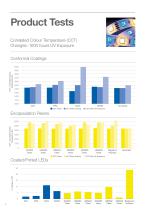
CCT - Correlated Colour _ CCT - Correlated Colour Clear Hazy Clear Clear A Epoxy CCT Initial CCT After Potting CCT After UV Exposure Clear Clear Clear Hazy Clear Clear A Epoxy
Open the catalog to page 6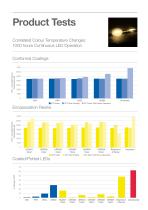
CCT - Correlated Colour _ CCT - Correlated Colour Product TestsCorrelated Colour Temperature Changes: 1000 hours Continuous LED OperationConformal Coatings 7000 Clear Clear Clear Hazy Clear Clear A Epoxy CCT Initial CCT After Potting CCT After 1000 Hours Operation
Open the catalog to page 7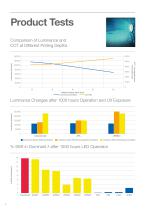
Product Tests Comparison of Luminance and CCT at Different Potting Depths CCT - Correlated Colour Temperature (K) UR5634 Potting depth [mm] CCT [K] Luminance [cd/sqm] Luminance Changes after 1000 hours Operation and UV Exposure Luminance [cd/sqm] Luminance Before Testing [cd/sqm] Luminance After 1000 Hours Operation [cd/sqm] Luminance After UV Exposure [cd/sqm] after 1000 hours LED Operation
Open the catalog to page 8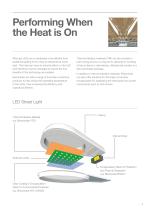
Performing When the Heat is On Although LEDs are considerably more efficient than traditional lighting forms, they do still produce some heat. This heat can have an adverse effect on the LED and therefore must be managed to ensure the true benefits of this technology are realised. Electrolube can offer a range of thermally conductive products to help reduce the operating temperature of the LEDs, thus increasing the efficiency and operational lifetime. Thermal interface materials (TIM) can be provided in both curing and non-curing forms, allowing for bonding of the surfaces or alternatively,...
Open the catalog to page 9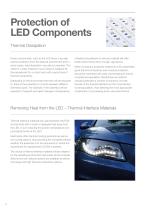
Protection of LED Components Thermal Dissipation Power components, such as the LED driver, may also require protection from the external environment and in some cases, heat dissipation may also be required. The need for a clear material in such cases is replaced by the requirement for a robust resin with a good level of thermal conductivity. Depending on the environment the resin will be exposed to, there is the possibility to choose between different chemistry types. For example, if the assembly will be exposed to frequent and rapid changes in temperature, a flexible polyurethane or...
Open the catalog to page 10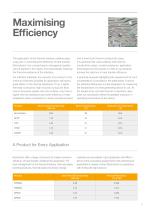
The application of the thermal interface material plays a big part in maximising the efficiency of heat transfer. Electrolube’s non-curing thermal management pastes can be applied in thin layers, thus dramatically reducing the thermal resistance at the interface. For interface materials, the viscosity of a product or the minimum thickness possible for application will have a great effect on the thermal resistance. Thus, a highly thermally conductive, high viscosity compound (that cannot be evenly spread onto the surface), may have a higher thermal resistance and lower efficiency of...
Open the catalog to page 11
Maximising Efficiency By applying a thin, uniform layer of a thermal interface material, it is possible to obtain the maximum efficiency of heat dissipation. It is also important to consider the operating temperature conditions throughout the lifetime of the product. Frequent changes in temperature are common in LED applications with devices switched on and off regularly. This results in the unit going through a thermal cycle, heating up once switched on and cooling again when powered down. Over the lifetime of the product, many thermal cycles take place and this may affect the positioning...
Open the catalog to page 12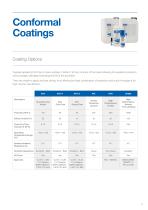
Coating Options Typically applied at 25-75pm, these coatings ‘conform’ to the contours of the board allowing for excellent protection and coverage, ultimately extending the life of the luminaire. They are simple to apply and fast drying, thus offering the ideal combination of protection and quick throughput for high volume manufacture.
Open the catalog to page 13All ELECTROLUBE catalogs and technical brochures
-
Electrolube Product Selector
8 Pages
-
Thermal Management
20 Pages
-
Conformal Coatings
20 Pages
-
Maintenance & Service Aids
16 Pages
-
Polyurethane & Epoxy Resins
16 Pages
-
Electrolube Company
8 Pages
Archived catalogs
-
Product Selector Chart
6 Pages
-
Contact Lubricants
16 Pages
-
Electrolube Product Catalogue
36 Pages
-
Thermal management
6 Pages
-
Automotive lubricants
4 Pages
-
New products
2 Pages















